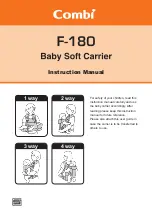
CÓMO MANTENER SEGURO A SU BEBÉ AL UTILIZAR ESTA MOCHILA PORTA BEBÉ
1) Esta mochila porta bebé está diseñada para el uso por adultos sólo mientras están caminando. Compruebe que todas las hebillas, pasadores,
correas y ajustes estén bien sujetos antes de cada uso.
2) Compruebe siempre que la nariz y la boca de su bebé no tienen obstrucciones a causa de la mochila porta bebé o de la ropa para asegurarse de
que puede respirar con facilidad.
3) El bebé debe estar mirando hacia usted hasta que pueda mantener erguida la cabeza sin ayuda.
4) Sujete firmemente a su bebé hasta que todas las hebillas y cierres estén en su sitio y las correas se hayan ajustado alrededor del cuerpo del usuario.
5) Asegúrese de que las partes del cuerpo del bebé y la piel no queden atrapadas o pellizcadas cuando esté cerrando las hebillas o los cierres.
6) Compruebe el bebé a menudo para asegurarse de que no tiene demasiado calor, que las correas están ajustadas pero no demasiado tirantes y que
el bebé está bien sujeto.
7) Si el bebé se queda dormido, por favor gírele la cabeza hacia el costado para proporcionarle una fuente de aire sin obstrucciones. Fig. A
8) Debería haber siempre suficiente espacio entre la cara de su bebé y el pecho para proporcionarle la ventilación adecuada. Fig. B
9) Verificar la correcta colocación según estas instrucciones, de todos los componentes de la mochila antes de introducir el niño en su interior.
Controle siempre que haya suficiente espacio alrededor de la cara del bebé para que éste reciba aire suficiente. Siempre asegúrese que la nariz y la
boca estén despejados y sin obstáculos de la mochila o ropa para asegurar que respira con facilidad.
Si se usa el porta bebé durante la lactancia materna, siempre mueva la cara del bebé lejos de la mama después de que el lactante lleve a cabo la
alimentación.
10) Si el niño pesa entre 3,5 y 4,5 Kg. debe colocar la tira de seguridad como se indica en la figura D. Verificar que el niño esté correctamente
colocado y que todos los anclajes de seguridad estén correctamente bloqueados. Los niños pequeños pueden caerse a través de la abertura de una
pierna. Para evitar caídas o estrangulaciones, ajuste SIEMPRE las aberturas de las piernas hasta el tamaño más pequeño adecuado para el infante,
Fig. D
Comprobar que las extremidades del bebé no quedan atrapadas y sus brazos y piernas están sueltos, Fig. C.
Instrucciones para el lavado:
•Para mantener la mochila porta bebé con un aspecto nuevo durante más tiempo, recomendamos que el cuidado habitual se limite a la limpieza de
manchas con un trapo húmedo. Utilice únicamente la lavadora si resulta necesario. Lave a máquina con agua fría, por separado, en ciclo para
prendas delicadas. Séquela colgando únicamente. No utilice lejía ni suavizante. No use la secadora de ropa. No la planche.
•Composición: Armazón 100% Poliester; Forro 100% Poliester; Cinchas 100% Polipropileno.
•La mochila KANGAROO de Jané, cumple con la norma de seguridad EN 13209-2: 2015 (Mochilas Portabebés)
A
B
C
D
10
11
Versatility of the baby carrier
osition 1. (See figure 1.1; position 1, page 2): From 0 to 5 months: In order to prevent
problems in the development of the hips, known as hip dislocation or dysplasia, we
recommend that the inner separator of the baby carrier is fastened at the front, so
that the baby’s legs have to be open wider, thereby preventing displacement outwards
of the femur head in the baby’s first few months. This will protect the child from
possible malformations and will aid correct maturation and fit of the hip and femur.
Position 2. (See figure 1.2; position 2, page 2): From 5 months upwards: Generally, the
inner separator of the baby carrier can now be fastened at the back as the baby’s hips
have now reached sufficient maturation. The baby’s legs can now be positioned closer
together, without exposing the baby to risk of hip malformation.
The Kangaroo baby carrier lets you carry your child in three positions from birth until the baby weighs 15 kilos, strengthening the mother-child
bond.
Baby carrier with careful design right down to the last detail:
1.- The design is comfortable for the adult to use as it spreads the weight out thanks to the dorsal belt, meaning the weight is not all concentrated
on the back as with a traditional backpack.
2.- It is fitted with a fully adjustable support for the baby’s neck. This support protects the baby while the adult is walking. Remember that for the
first few months the baby cannot support his head by himself. This support can also be folded when the baby is in the facing forwards position
giving the child better visibility.
3.- The position of the opening for the baby’s legs (frog leg position), prevents problems of hip development and maturation (congenital hip
dislocation).
4.- Thanks to the full opening, it is very easy to get the child out to change his position at any time.
1
Baby’s legs held against the adult’s hip.
2
Baby’s legs hanging down.
Parts description (See figure 2)
Shoulder straps. Wide straps for comfort and stability
(7 cm.), to distribute the weight evenly
Adjustable headrest. Can be folded down when the child
is facing forwards
Breathable interior suitable for any season
Padded material to hold the baby’s back firmly
Lower back support giving greater comfort, stability and
safety: 1º Adjustable Velcro and 2º Safety buckle
Quick release clips
Dorsal fastening harness
Inner separator for the 2 leg positions for the baby
A
B
C
D
E
F
G
H
1.1 1.2
FIGURE 1
FIGURE 2
USER MANUAL
IMPORTANT! READ CAREFULLY AND KEEP FOR
FUTURE REFERENCE
B
D
H
A
G
F
C
E


































